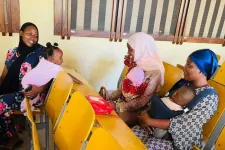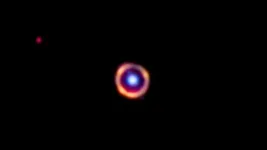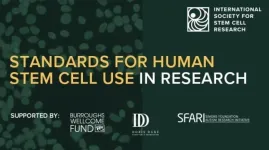(Press-News.org) Scientists from the UCLA Jonsson Comprehensive Cancer Center have developed a new method to bioprint miniature tumor organoids that are designed to mimic the function and architecture of real tumors. The improved process allows researchers to use an advanced imaging method to study and analyze individual organoids in great detail, which can help researchers identify personalized treatments for people with rare or hard-to-treat cancers.
The method is described in the journal Nature Communications.
“Tumor organoids have become fundamental tools to investigate tumor biology and highlight drug sensitivities of individual patients,” said Alice Soragni, PhD, an assistant professor in the department of Orthopaedic Surgery at the David Geffen School of Medicine at UCLA and member of the UCLA Jonsson Comprehensive Cancer Center. “However, we still need better ways to anticipate if resistance could be arising in a small population of cells, which we may not detect using conventional screening approaches. This is truly important, particularly as organoid-based drug predictions are starting to be leveraged clinically.”
These miniaturized tumors, called organoids, can be grown in a lab using cell lines or patients’ own cells to better understand human biology and diseases. By recreating patient tumors, researchers can test different drugs to see if the tumor will respond well or poorly to the treatment. This can make it easier for physicians to choose the best therapy for their patients.
While these mini tumors have helped improve drug modeling and are becoming invaluable tools for testing the efficacy and safety of potential drugs, it is still challenging for current models to capture underlying tumor heterogeneity which often drives clinically observed resistance to therapy. One of the main limitations of this approach is that current methods fail to capture changes or differences within the organoid samples that may be responsible for the resistance to therapy that is observed in clinical settings.
To overcome these challenges, the team of researchers created a method that uses a bioprinting technique to print cells in a thin layer of support extra-cellular proteins to give rise to 3D mini-tumors without altering the tissue histology and gene expressions. The team combined bioprinted cells with high-speed live cell interferometry (HSLCI), an imaging system that is a non-destructive approach used to observe and measure the weight of living cells in real-time. These methods are then combined with machine learning algorithms to analyze and measure individual organoids.
“By using this method, we are able to accurately measure the masses of thousands of organoids simultaneously,” said Dr. Michael Teitell, director of the UCLA Jonsson Comprehensive Cancer Center and co-senior author of the study. “This information helps identify which organoids are sensitive or resistant to specific therapies, which can be used to quickly select the most effective treatment options for patients.”
With the new method combination, researchers confirmed that they could measure the growth patterns of the bioprinted tumor cells over time to see how the cells responded to different drugs or treatments.
“The measurements were done in a way that did not damage or destroy the organoids, allowing for non-invasive analysis of their growth and drug responses,” noted Teitell.
The researchers were able to identify an effect of certain drugs on cells as soon as six hours from adding the therapies. The team also identified small groups of cells that did not respond to the drugs, even within very homogeneous cell line samples consisting mostly of cells that were responsive to the treatment.
“This new pipeline has enhanced the quality and depth of information we can get from drug screening of 3D models of disease,” said Soragni. “We are now applying the same approach to organoids established from hard-to-treat, rare cancers.”
The researchers will leverage the new approach to uncover novel therapeutic avenues and mechanisms of resistance to eventually develop personalized treatment strategies.
The co-first authors are Peyton Tebon, Bowen Wang and Alexander Markowitz, all from UCLA. Other UCLA authors include Ardalan Davarifar, Brandon Tsai, Alfredo Gonzalez, Sara Sartini, Huyen Nguyen, Nasrin Tavanaie, Thang Nguyen and Paul Boutros.
The study was supported in part by grants from the National Institutes of Health, the Department of Defense, a National Science Foundation Graduate Research Fellowship, a Eugene V. Cota Robles Fellowship and the Air Force Office of Scientific Research.
END
Fine-tuning 3D lab-grown mini tumors to help predict how patients respond to cancer therapies
UCLA researchers develop new way to grow and measure how tumor organoids respond to therapy
2023-06-06
ELSE PRESS RELEASES FROM THIS DATE:
Social media ‘trust’/’distrust’ buttons could reduce spread of misinformation
2023-06-06
The addition of ‘trust’ and ‘distrust’ buttons on social media, alongside standard ‘like’ buttons, could help to reduce the spread of misinformation, finds a new experimental study led by UCL researchers.
Incentivising accuracy cut in half the reach of false posts, according to the findings published in eLife.
Co-lead author, Professor Tali Sharot (UCL Psychology & Language Sciences, Max Planck UCL Centre for Computational Psychiatry and Ageing Research, and Massachusetts Institute of Technology) said: “Over the past few years, the spread of misinformation, or ‘fake news’, has skyrocketed, ...
Programmable 3D printed wound dressing could improve treatment for burn, cancer patients
2023-06-06
One of the challenges in treating burn victims is the frequency of dressing changes, which can be extremely painful.
To bring relief to this and other problems, University of Waterloo researchers have created a new type of wound dressing material using advanced polymers. This new dressing could enhance the healing process for burn patients and have potential applications for drug delivery in cancer treatment as well as in the cosmetic industry.
"To treat burn victims, we can customize the shape using a 3D printer, secondly, the material has fine-tuned surface adhesion, which is a key feature", said Dr. Boxin Zhao, a professor in Waterloo's Department of ...
Do chatbot avatars prompt bias in health care?
2023-06-06
Chatbots are increasingly becoming a part of health care around the world, but do they encourage bias? That’s what University of Colorado School of Medicine researchers are asking as they dig into patients’ experiences with the artificial intelligence (AI) programs that simulate conversation.
“Sometimes overlooked is what a chatbot looks like – its avatar,” the researchers write in a new paper published in Annals of Internal Medicine. “Current chatbot ...
Team develops smartphone app to enhance midwifery care in Tanzania
2023-06-06
An international research team from Tanzania and Japan created a smartphone app and conducted a pilot study of how the app might be used to improve midwives’ knowledge and skills in Tanzania. Their study focused on the app’s potential effects on the learning outcomes of midwives and birth preparedness of pregnant women in Tanzania.
The team’s work is published in the journal PLOS ONE on March 31, 2023.
“The smartphone app for midwives showed significant improvements in their learning outcomes, leading to better birth preparations for pregnant women in Tanzania. This study highlights the potential of leveraging technology ...
Webb telescope detects universe’s most distant organic molecules
2023-06-06
An international team of astronomers has detected complex organic molecules in the most distant galaxy to date using NASA’s James Webb Space Telescope.
The discovery of the molecules, which are familiar on Earth in smoke, soot and smog, demonstrates the power of Webb to help understand the complex chemistry that goes hand-in-hand with the birth of new stars even in the earliest periods of the universe’s history. At least for galaxies, the new findings cast doubt on the old adage that where there’s smoke, there’s ...
Breastfeeding for longer may be linked to better exam results in later life
2023-06-06
Children who are breastfed for longer appear to be more likely to gain slightly better results in their school GSCEs at age 16 compared with non-breastfed children, suggests a study published online in the journal Archives of Disease in Childhood.
The evidence of improved educational outcomes is still apparent even when various factors are taken into account such as people’s socio-economic status and their parents’ intelligence.
Previous studies have suggested that children breastfed for longer have improved educational outcomes later in life. However these are relatively scarce, and ...
Close contact intervention between a mother and her premature baby may reduce risk of mortality by almost a third
2023-06-06
A method of care involving skin-to-skin contact between a mother and her prematurely born or low birth weight baby appears to impact the child’s chances of survival significantly, suggests a study published online in the journal BMJ Global Health.
Starting the intervention within 24 hours of birth and carrying it out for at least eight hours a day both appear to make the approach even more effective in reducing mortality and infection, researchers found.
The method of care known as ‘Kangaroo mother care’ (KMC) involves an infant being carried, usually by the mother, in a sling with skin-to-skin contact ...
Defibrillators used in just 10 per cent of out of hospital cardiac arrests - study shows
2023-06-06
Defibrillators are being used in just one in ten cardiac arrests where the lifesaving devices are available, according to new research presented at the British Cardiovascular Society Conference in Manchester.
The research drew upon data from the East of England Ambulance Service and The Circuit, the national defibrillator network developed by the British Heart Foundation (BHF). The Circuit maps the location of defibrillators across the whole of the UK, so that emergency services can direct bystanders to the nearest defibrillator in the event of ...
Virtual blood vessel technology could improve heart disease care
2023-06-06
Patients with heart disease could benefit from less extensive interventions thanks to cutting-edge technology that creates 3D computer models of blood flow through the heart's arteries, according to research presented at the British Cardiovascular Society in Manchester.
When the research team trialled the VIRTUHeartTM technology with doctors treating heart attack patients, they found that using it would have changed the treatment of more than 20 per cent of patients. In many cases, it would have led to fewer patients undergoing an invasive procedure such ...
The ISSCR releases global standards to enhance rigor and reproducibility of stem cell research
2023-06-06
The International Society for Stem Cell Research (ISSCR) today released the ISSCR Standards for Human Stem Cell Use in Research, an international collaboration aimed at enhancing rigor in preclinical research and ultimately strengthening the pipeline of therapies for patients.
“This nearly two-year initiative is groundbreaking for the global stem cell research community,” said Haifan Lin, ISSCR president. “The international standards will make a big difference in the quality of science that is performed and published worldwide.”
The ISSCR is the preeminent international stem cell research society with a reputation ...
LAST 30 PRESS RELEASES:
Plant hormone allows lifelong control of proteins in living animal for first time
Swedish freshwater bacteria give new insights into bacterial evolution
Global measures consistently underestimate food insecurity; one in five who suffer from hunger may go uncounted
Hidden patterns of isolation and segregation found in all American cities
FDA drug trials exclude a widening slice of Americans
Sea reptile’s tooth shows that mosasaurs could live in freshwater
Pure bred: New stem cell medium only has canine components
Largest study of its kind highlights benefits – and risks – of plant-based diets in children
Synergistic effects of single-crystal HfB2 nanorods: Simultaneous enhancement of mechanical properties and ablation resistance
Mysterious X-ray variability of the strongly magnetized neutron star NGC 7793 P13
The key to increasing patients’ advance care medical planning may be automatic patient outreach
Palaeontology: Ancient tooth suggests ocean predator could hunt in rivers
Polar bears may be adapting to survive warmer climates, says study
Canadian wildfire smoke worsened pediatric asthma in US Northeast: UVM study
New UBCO research challenges traditional teen suicide prevention models
Diversity language in US medical research agency grants declined 25% since 2024
Concern over growing use of AI chatbots to stave off loneliness
Biomedical authors often call a reference “recent” — even when it is decades old, analysis shows
The Lancet: New single dose oral treatment for gonorrhoea effectively combats drug-resistant infections, trial finds
Proton therapy shows survival benefit in Phase III trial for patients with head and neck cancers
Blood test reveals prognosis after cardiac arrest
UBCO study finds microdosing can temporarily improve mood, creativity
An ECOG-ACRIN imaging study solves a long-standing gap in metastatic breast cancer research and care: accurately measuring treatment response in patients with bone metastases
Cleveland Clinic presents final results of phase 1 clinical trial of preventive breast cancer vaccine study
Nationally renowned anesthesiology physician-scientist and clinical operations leader David Mintz, MD, PhD, named Chair of the Department of Anesthesiology at the UM School of Medicine
Clean water access improves child health in Mozambique, study shows
Study implicates enzyme in neurodegenerative conditions
Tufts professor named Fellow of the National Academy of Inventors
Tiny new device could enable giant future quantum computers
Tracing a path through photosynthesis to food security
[Press-News.org] Fine-tuning 3D lab-grown mini tumors to help predict how patients respond to cancer therapiesUCLA researchers develop new way to grow and measure how tumor organoids respond to therapy



